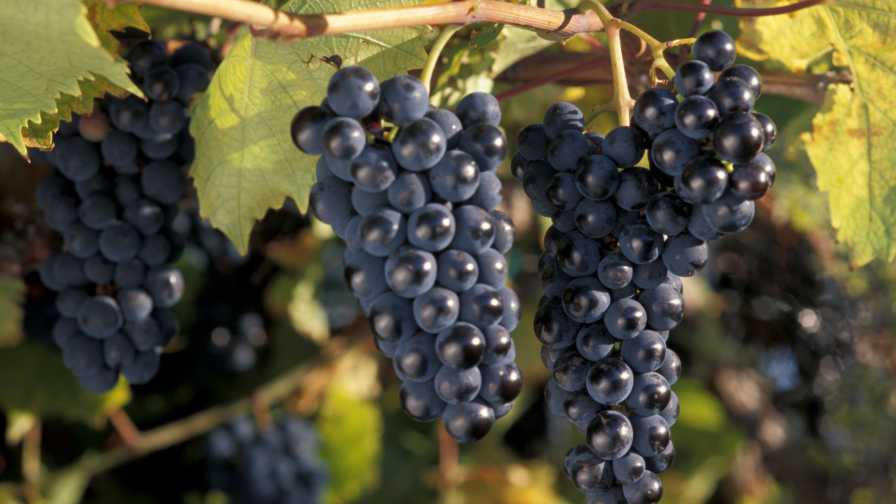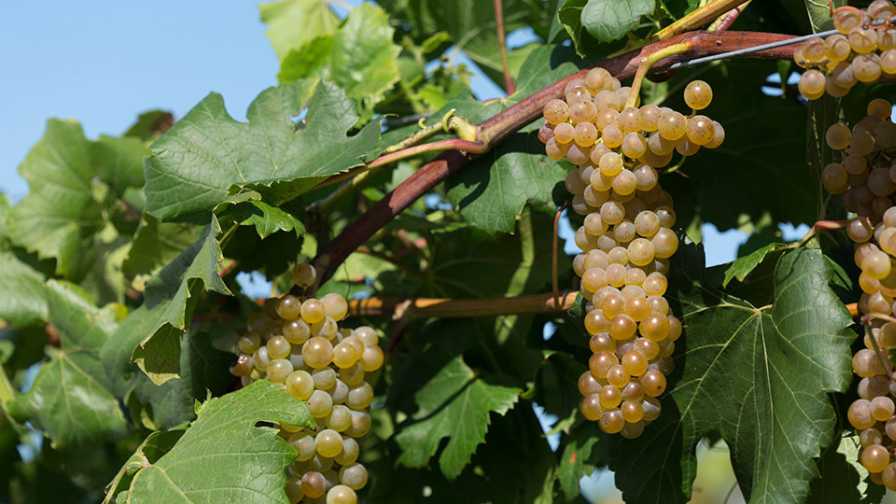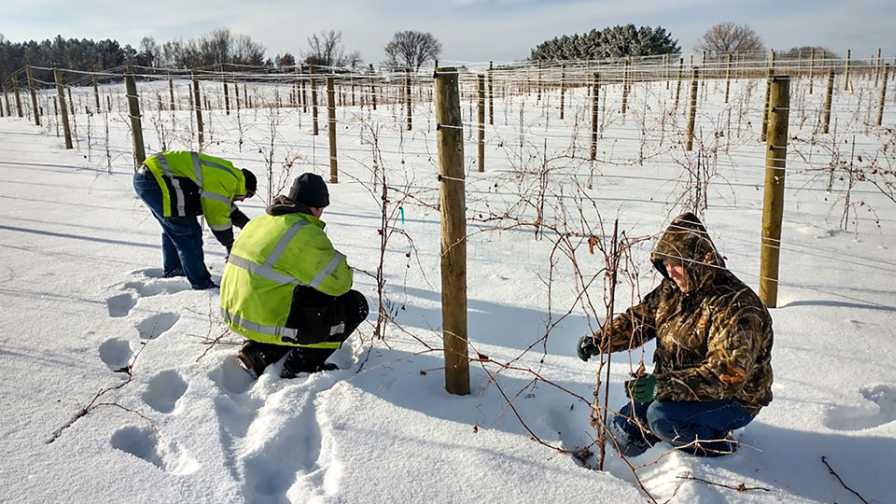Learn Tricks of the Trade in Cold Climate Grape Growing

‘Marquette’ is a red, cold climate wine grape variety from the University of Minnesota.
Photo by David L. Hansen
Cold climate grape varieties are getting more popular due not only to their cold hardiness, but they are producing good quality wines. Wanting to learn more about these exciting varieties, I contacted Annie Klodd, University of Minnesota Statewide Extension Educator for Fruit Crops, who presented “Growing Minnesota Cold-Climate Grapes” at the 2020 Great Lakes Expo. Klodd gave an overview of available varieties, discussing cold tolerance, pruning considerations, sulfur sensitivity, Brix, pH, and titratable acidity (TA) targets.
“Great wine starts from great grapes, and I have tasted some great wine from cold-climate grapes during my time in Minnesota,” Klodd, who grew up on an Iowa vineyard, says. “Varieties like ‘Itasca’, ‘Marquette’, ‘LaCrescent’, ‘Frontenac’, and ‘Petite Pearl’ have allowed innovative winemakers to craft creative and high-quality wines while supporting local growers. Cold climate grape varieties make this possible in the upper Midwest, where temperatures regularly dip below 0°F in the winter.”
She also noted that ‘Marquette’, a 2006 red wine grape release from Minnesota, is gaining popularity among consumers, and a dry red Marquette wine won the best of the class in a wine competition in Michigan in both 2017 and 2019.
“Currently my favorite variety is ‘Itasca’ because of how nicely it grows in the vineyard, and it’s been exciting to taste a few of the first ‘Itasca’ wines this past year,” Klodd says. ‘Itasca’, a white wine grape variety, is the newest release from the University of Minnesota in 2017. Unlike other grape varieties from the University of Minnesota, ‘Itasca’ has lower acidity and high sugar levels.

‘Itasca’, the newest release from the University of Minnesota, is known for its high sugar content, low acidity, and exceptional cold hardiness.
Photo by David L. Hansen
Development of cold-hardy grape varieties in Minnesota goes back a few years. Klodd mentioned influential people like Elmer Swenson (1913 – 2004), Dr. Matt Clark with the University of Minnesota’s Grape Breeding and Enology lab, and Tom Plocher. Swenson released 27 grape varieties by himself or with the University of Minnesota. Plocher is the breeder for ‘Crimson Pearl’, ‘Petite Pearl’, and ‘Verona’.
Klodd listed some of the hardiest varieties for Minnesota USDA Zone 4. White grape varieties include ‘Brianna’, ‘Edelweiss’, ‘Frontenac Gris’, ‘Blanc’, ‘Itasca’, ‘LaCrescent’, ‘LeCrosse’, ‘Swenson White’, ‘Prairie Star’, and ‘St. Pepin’. Reds include ‘Crimson Pearl’, ‘Frontenac’, ‘Marechal Foch’, ‘Marquette’, ‘Petite Pearl’, ‘Sabrevois’, ‘St. Croix’, and ‘Swenson Red’. Among them, ‘Itasca’ shows the greatest cold hardiness and only suffered a 15.6% primary bud loss after a polar vortex in 2019.
TRAINING FOR COLD CLIMATES
The training system you choose for your cold climate grape varieties should be based on the variety and the training systems that growers are more comfortable with, Klodd says. ‘Itasca’, ‘LaCrescent’, ‘Marquette’, ‘Petite Pearl’, and ‘Crimson Pearl’ can be trained to either Vertical Shoot Positioning System (VSP) or High Wire Cordon while ‘Frontenac’, ‘Frontenac Gris’, ‘Frontenac Blanc’, ‘Brianna’, and other Swenson series varieties should be trained on the high wire cordon system.
You also need to take soil organic matter content and weather conditions into consideration when selecting a training system. VSP may not be suited for these cold-climate grape varieties in warmer regions of the Midwest, since these varieties could grow too vigorously. As we all know, vine vigor is not desirable for wine grapes.

Greg Sandager, Jake Powell, and Jason Kleschult prune cold hardy grapevines at Rustic Roots Winery in Scandia, Minnesota.
Photo by Annie Klodd
PRUNING IN SNOW
“One of my favorite activities in this job is teaching new growers how to prune, even when we’re 8 inches deep in snow,” Klodd says. She recommends a 3” bud (node) spacing on a cordon for University of Minnesota varieties such as the ‘Frontenac’ family, ‘Itasca’, ‘LaCrescent’, ‘Marquette’; and ‘Crimson Pear’ and ‘Petite Pearl’. About 4” bud (node) spacing is recommended for Swenson or “Labrusca” varieties, such as Brianna, Edelweiss and Swenson Red. Annie says the exact spacing is important to avoid “spur creep” where spurs are getting farther and farther away from the cordon.
A year of spring frosts and freezes in 2020 showed that with the above-mentioned varieties, very good yield can still come from secondary and tertiary buds after spring freeze(s).
Klod says that Brix, pH, and TA (g/L) targets for ‘Brianna’ are 16-18, 3.0-3.25, and 9-11. For ‘Itasca’, they are 23-25, 3.1-3.3, and 8-10.
Klod offers these additional resources:
- Wine Grape Comparisons
- Grape copper & sulfur sensitivity
- Establishing cordons
- Growing Grapes in Minnesota guide
- Midwest Fruit Pest Management Guide
- The “Cold Climate Grape Grower Webinar Series” will be jointly offered by the University of Minnesota and the University of Wisconsin in 2021. For the latest information on these programs, subscribe to “UMN Extension Fruit and Vegetable News.”
You can consult your state’s grape Extension professionals for specific recommendations since growing can vary from one state to the next, or even within different parts of the same state.
You also can reach out to Klodd for additional information at https://horticulture.umn.edu/annieklodd.










